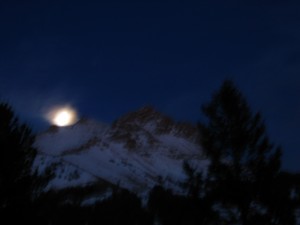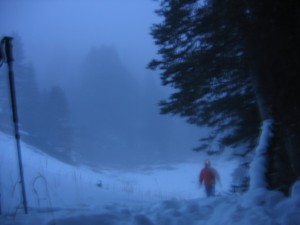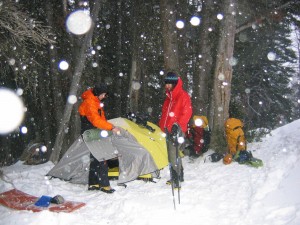
Justin enjoys moonlit walks in the mountains, margaritas on the rocks, and the occasional Peter Cetera love song. He wants you to know that he'll be the hero you're dreamin' of.
After a week or so of deliberation, we finally pulled the trigger on a trip back to the Sphinx. Several intervening factors led to the decision: Jason wanted to lead the first pitch, I wanted to find my crampons, and we were able to talk Ryan, one of Jason’s old climbing buddies, into coming along to further split up the weight and trail-breaking duties. Instead of sleeping in the parking lot and tagging the climb in one 17-hour push like last time, we decided to leave early on Monday afternoon and camp at the saddle; we’d succeed in shaving five miles off our climbing day, and we’d be able to sleep an extra three hours.
That’s what we like to call a “win-win situation.”
It didn’t make a difference in the end.
We hiked in by moonlight and set up shop in a protected grove just beneath the saddle. A storm blew in during the night. By the time we woke up, the snowfall was so heavy we couldn’t see the peak from the tent. If you’re up on a mountain when a storm comes in, you deal with it because, well, what else are you going to do? But you never want to climb into a storm if you can avoid it – that’s day one stuff. We slept until sunrise and laid around in the tent telling stories. When the snow refused to lighten after another hour, we packed up and left. We swung no tools, we hung no ropes, and we located no crampons.

Good morning, sunshine.
This is a scenario that plays itself out time and again in the mountains, and if your climbing interests extend past the gym, getting shut down is one of those things you’ll have to handle eventually. The more you push yourself – in terms of location, altitude, and goal – the more subjective your definition of “success” becomes.
Was our recent trip to the Sphinx successful? By the strictest of measures, no. We didn’t finish the climb or find my crampons, so our two main objectives eluded us. At the same time, we didn’t lose any crampons, and we made it back to the car better friends than we were when we left. We’re also all psyched to go back and try it again, and that is a grand success in and of itself.
As with many things in life, it’s important to find a balance. I love being outside, and I absolutely find a special and unique satisfaction in and among nature. I recognize and appreciate the beauty of the mountains, the rivers, and the stars; they are my cathedrals.
Even still, it is not enough for me to remain a spectator in these settings. I don’t run ultra-distance trail races because the final ten miles of the trail are significantly more profound than the first twenty; I run them because I couldn’t stand to challenge myself like that on some boring road. The Grand Canyon is, for me, a spectacular abstract concept, and it will remain so right up until the time I’m able to see it from a boat on a three-week float trip. I am eternally fascinated by the miraculous and intricate process that causes a waterfall to freeze into a solid flow of ice; it is, in fact, a perfect thing to ponder while anchored to that same waterfall by three ice screws and a length of 7mm cord.

Success.
I never want to reach a point in my climbing where a five-mile retreat through pristine falling snow becomes nothing but a five-mile retreat; I also never want to reach a point where that same five-mile retreat becomes a perfectly satisfying winter stroll. I am driven by the climbing, and I am restored by nature. As long as I remain both driven and restored, I remain successful no matter the outcome.


Justin,
Old friend, I am enjoying reading about your adventures climbing towards that big, beautiful sky. Thank you for the diversion from the daily grind. I’m just now getting into the hiking game and your vivid descriptions make me want to learn more and spend more time out of the suburbs and in the mountains.
Best to you —
Dave Pusey